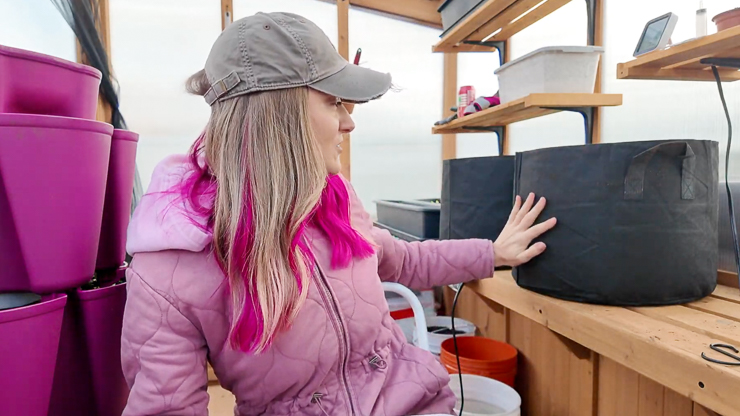Have you ever gotten a seed catalog in the mail?? There’s nothing like getting a beautiful seed catalog in the mail to make you drop some serious cash on seeds. But over the years, I have narrowed down some of the things I like to grow and the places I like to get seeds from.
Sure, I love to try new things. But I’d say about 80% of my garden is stuff I know we love to grow and eat. And the 20% that remains is my portion for fun 🙂 So let’s walk through some of my favorite sources for seeds, including everything from traditional companies to seed swaps and libraries.

1. Reputable companies with good business practices
When purchasing seeds from companies—or when purchasing anything from companies, really—I like to give my money to businesses that have values as closely aligned to mine as possible. Sure, this isn’t always something I can do…I shop at Amazon. I’m not perfect.
But for things like seeds, there are some really great options out there. I love the Southern Exposure Seed Exchange, which usually has a seed display at one of my favorite local nurseries. Check your local nurseries before ordering online!
The Southern Exposure Seed Exchange is a worker-run cooperative, which means that every worker has a voice in the company and they all receive equal compensation “regardless of the economic value traditionally placed on the jobs.”
They promote seed saving, ecological agriculture, reducing energy use, providing locally adapted varieties, and regional food production. And they specialize in heirloom, open-pollinated, and disease- and insect-tolerant varieties. Love all of that!
My cousin Jimmy also recommends Johnny’s Select Seeds and Fedco Seeds. Johnny’s is 100% employee owned and breeds all seeds using traditional natural crossing methods. Fedco is based in Maine and is a worker/consumer-owned cooperative specializing in gardening, farming and orcharding supplies. Love that they started in 1978 as a few friends harvesting seeds to save money while not sacrificing quality.


2. Dollar stores
The next source I want to touch on is the dollar store. Now…this one doesn’t exactly fit into the “sustainable and equitable business practices” category. I know. But I also know that sometimes cost can be a hurdle.
You won’t ever catch me snarking on people who grow dollar store seeds. My mom got a dollar store packet of okra seeds, and she grew an absolutely unbelievable amount of okra from it. Below on the left is the start of a pole bean plant I grew from dollar store seeds that grew wonderfully, and I’ve also grown dollar store zinnia seeds.
If you want to get your feet wet with gardening and don’t have a big budget, why not try it? There are a couple of other low cost options I’ll touch on in the next sections that you may want to consider before dollar store seeds. But I see this topic brought up SO often in plant groups and spaces that I wanted to touch on it. I’ve grown dollar store seeds with a lot of success!


3. FreeHeirloomSeeds.org
If cost is a hurdle definitely check out the resource FreeHeirloomSeeds.org. Their mission is all about distributing free heirloom seeds to the public and encouraging sustainability, self reliance, and species preservation. They ask for donations to cover shipping and processing costs, but it isn’t mandatory.
As of writing this, you PayPal them $10 to cover shipping and processing and choose 15 seed types from their extensive list. Yes, the website looks like it was made on Geocities in 1995. Yes, the color combinations make it hard to read. Yes, the process is cumbersome…you PayPal them $10 and then send an email with information they outline. But it’s all pretty clear and easy if you just read and follow the steps.
I ordered some cool weather crops from them recently and was shocked that I got a package with everything within a few days! I didn’t get everything I wanted, but they gave me a few doubles, which is great. And I get to try out a few new varieties. I’d recommend giving it a go for sure!

4. Local plant/seed swaps
I also love local plant and seed swaps. I live in an area of Maryland with a pretty active plant community. Mostly for houseplants, but there are a lot of us who are really into gardening, too. We have a group of wonderful women who run a Facebook plant swap group for our area. They put on monthly swaps at a local brewery, too.
The last one I attended, I hit up the free table to drop off supplies, plant propagations, and other stuff—and to browse for myself! I was totally delighted to grab a bunch of these free brand new grow bags. Someone had used just one from the package and brought the rest in!
I got them and filled them with the $1 clearance raised bed soil we got at the end of the growing season and am planning to use them for growing potatoes in a few months. However, I’m trying to grow greens in the greenhouse in them through the winter while I wait for potato time. I also got several free seedling heat mats!
You area might also have “seed libraries” through your local library system. I’d recommend searching online for “you location” and “plant swap,” “seed swap,” or “plant trade group.” You can search on Facebook, too. Facebook is the worst, but it is great for connecting people with stuff like this.

5. Saving my own
And, of course, I’ve been saving more and more of my own seeds every year! Saving seeds is not as challenging as it might sounds for many plants. Heirloom and open-pollinated varieties are the best plants to save seeds from because the seeds will produce a plant that more closely resembles its parent.
Hybrid seeds are manually cross-pollinated between two types of plants to breed for ideal characteristics, like disease resistance, for example. Hybrid seeds definitely have their place—I grow two types of hybrid cherry tomatoes every year. But I try to keep the vast majority of my seeds to open-pollinated seeds.
Seed saving is a topic that deserves its own post, for sure. And I’m still diving deeper into the topic beyond just the basics. But a good rule of thumb is that if you grow heirloom or open-pollinated varieties, you can probably save seeds from the plants to grow next year.






How I organize my seeds
Once you really get into seed saving, you’ll quickly find yourself overwhelmed. You’ll swear you’ll remember what’s in something, but you won’t. And then you’ll put stuff in bags and label them, but they’ll spill out into drawers. The best thing I ever found was this seed organizer—that’s my affiliate link.
I love, love, love this thing. The containers are air tight, so you need to make usre your seeds are completely dry before you store them. But I have never had any issues storing all kinds of seeds, including ones I’ve harvested and dried myself.
I label all of the little canisters with numbers, and then I have a Google Docs spreadsheet I use to keep a record of what everything is. This is so easy for me to manage, and I can also link to where I purchased the seed from or put notes about when I saved it or where I had it planted. I definitely recommend this handy little thing!


Pin this!


Brittany is a seasoned DIY home and garden expert, running a creative brand since 2014 that inspires others with approachable plant care guides, woodworking tutorials, and decor projects. She is a certified project manager and has completed extensive coursework in the art and science of growing your own plants. Her work has been recognized by major publications, and she routinely collaborates with fellow DIY industry leaders—but her favorite thing to do is inspire you! Learn more about her here.

Hi Brittany, Thank you for this resource. Where our seed comes from is an important and ethical issue. Some of the seed sources you mentioned purchase seed from companies who operate in Israel. Genesis Seed Company is a large international seed supplier. Asking if companies will pledge that their seed does not and will not come from Israeli companies is one small but important thing we can all do. Thank you.
Thanks for stopping by and for sharing–I’ll have to look into Genesis Seed Company. I’m a rabbit hole type person…how do you find out where seed companies get their seeds from? I’d honestly assumed in good faith that all of the companies I mentioned in this post (except the dollar store) were producing in-house.